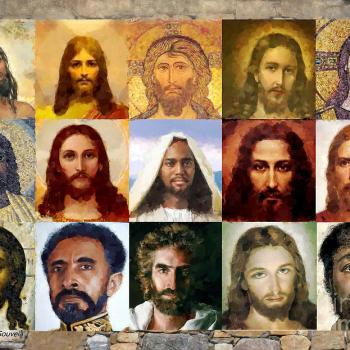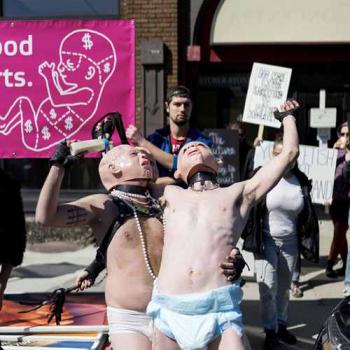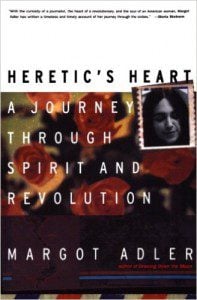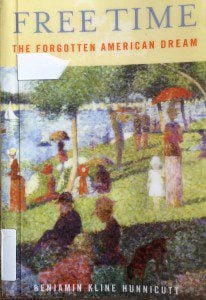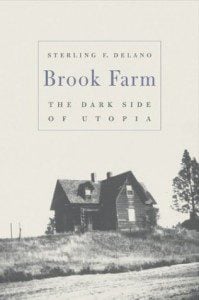Note: This post is the first part in a Lenten series on Joyce Rockwood Hudson’s book Natural Spirituality: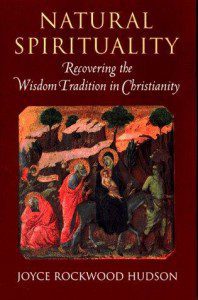 Recovering the Wisdom Tradition in Christianity.
Recovering the Wisdom Tradition in Christianity.
22 God created me Wisdom at the beginning of God’s work, the first of God’s acts of long ago. 23 Ages ago I was set up, at the first, before the beginning of the earth. 24 When there were no depths I was brought forth, when there were no springs abounding with water. 25 Before the mountains had been shaped, before the hills, I was brought forth — 26 when God had not yet made earth and fields, or the world’s first bits of soil. 27 When God established the heavens, I was there, when God drew a circle on the face of the deep, 28 when God made firm the skies above, when God established the fountains of the deep, 29 when God assigned to the sea its limit, so that the waters might not transgress God’s command, when God marked out the foundations of the earth, 30 then I was beside God, like a master worker; and I was daily God’s delight, rejoicing before God always, 31 rejoicing in God’s inhabited world and delighting in the human race. 32 “And now, my children, listen to me: happy are those who keep my ways.
Proverbs 8
Joyce Rockwood Hudson is the founder and director of the Natural Spirituality Program at Emmanuel Episcopal Church in Athens, Georgia. She is the daughter of an Episcopal priest, and was happily enmeshed in the life and rituals of the Anglican Christian tradition from an early age. But in her late thirties, she had a number of unexpected firsthand experiences that radically altered her worldview.
Two friends, along with their respective children, had recently stayed with Joyce’s family. On a previous stop on their road trip, the two friends had been to visit their respective parents. Susan, one of her two friends, was particularly elated about how well her visit with her mother had gone. Joyce’s friend was an actress, and her mother disapproved both of her secular lifestyle and of the amount of time her acting career caused her to be away from her husband and two children. Over the years, her mother’s frequent disappointment had carved an increasingly large gulf between mother and daughter.
But on this recent trip — only the day before arriving at Hudson’s home — Susan and her mother had gone to see Terms of Endearment in the theater. Some of you may recall seeing this 1983 film. It stars Shirley MacLaine, Debra Winger, and Jack Nicholson, and won five Academy Awards, including Best Picture, Best Director, Best Adapted Screenplay, Best Supporting Actor for Jack Nicholson, and Best Actress for Shirley MacLaine.
The film spans three decades of the relationship between a mother and daughter. The wrenching plot twist is the daughter’s diagnosis with cancer, and the mother’s emotional journey to come to terms with her daughter’s death. Susan was also the daughter of two young children, making the parallels between the film and real life particularly poignant. After the film, Susan and her mother had a beautiful breakthrough conversation of confession, apology, healing, and reconciliation. The next day at Joyce’s house, Susan couldn’t stop talking about how overwhelmed and grateful she was for that day with her mother.
In the morning, the two friends packed the car and hit the road. Twenty minutes later, Joyce’s phone rang. There had been a wreck. Everyone was fine except for Susan, who was in critical condition.
Joyce writes:
For several hours we clung to hope. But then I began to think about what had happened between her and her mother — the two of them watching that particular movie and the reconciliation that had followed. It was too perfect. I could see that the end had already been arranged. Susan was going to die…. I suddenly saw vividly in my mind’s eye a newspaper page, more than half of which was taken up with an obituary for Susan, including her picture. It was very clear, no mistaking what it was. I began to cry. At this same time my husband called with news that Susan had just died.
This tragedy marked the end for me of the world I had always known and that everyone around me seemed only to know — a world in which human consciousness is the highest source of knowledge and human will is the greatest purposeful power…. The world of ordinary consciousness did not allow for purposefulness in such events as Susan’s last day with her mother. (5-6)
From a secular, purely scientific perspective, Joyce’s experience would be deemed a coincidence: it was merely coincidental that Susan and her mother went to see that particular film and had a transformative reconciliation on the day before Susan’s death; it was merely coincidental that Joyce had a vision of Susan’s death at the moment her friend died, even though she was miles away from the hospital. I will readily grant that we have to be extraordinarily careful about attributing causation to God and meaning to events.
And I am, by no means, promoting a variation of the harmful canard that “everything happens for a reason.” But, at least for Joyce Rockwood Hudson, calling these two events “mere coincidences” did not adequately explain the powerful impressiveness of her personal experience. Even if you, like me, are not fully persuaded by Joyce’s interpretation of how God was present in “causing” these events, the larger point is the way that these events opened her eyes to a different way of seeing the world.
Joyce’s day-to-day life, on one level, was not substantially different in the period after the wreck. She still lived in the same house, and had the same job. She cared for her family and had fun with friends, ran errands and did chores. But while going about her normal life, it was as if a new level of meaning had been layered on top of her old worldview. She increasingly had eyes to see and ears to hear “very personal and specific meaning” in events that would have previously seemed coincidental, random, and generic (8).
She writes:
A door would slam as certain words were being spoken…. I would notice them and think about them and see that something of importance to my own life was being emphasized. An image would arise in my mind as I was driving down the road, or perhaps a line from a song…. I would catch it and think about it and understand that something was being hinted at. Dreams would come tumbling darkly in the night, punctuating the patterns of meaning I was struggle to patch together in my waking life. (8)
After about a year of increasingly discerning meaning where others might find only coincidence, Joyce stumbled upon the autobiography of the twentieth-century Swiss psychiatrist Carl Jung (1875–1961), who brought intellectual acumen, cross-cultural sensitivity, and psychological insight to bear on his similar firsthand experiences with “meaningful coincidences.”
In Jungian terms, Joyce was experiencing a “confrontation with the unconscious” (9). She was increasingly open to the ways in which the everyday material world that we experience through our five senses is infused with a larger sense of meaning and purpose. She began to see how experiences in the outer world had strong parallels to her inner experience and vice-versa. And when she examined these resonances between the inner and outer world, she found guidance, insight, and encouragement on her journey toward spiritual growth and greater wholeness.
~~~~~~~~
Our scripture for this morning from Proverbs 8 says that, “God created Wisdom at the beginning of God’s work, the first of God’s acts of long ago.” And the way of seeing the world that Joyce and Jung describe is about learning to perceive the deep wisdom that suffuses the world if we have eyes to see and ears to hear.
And learning to perceive the deep, abiding, organic, emergent, and evolving wisdom that is all around us and within us is the focus of Joyce Rockwood Hudson’s book Natural Spirituality: Recovering the Wisdom Tradition in Christianity, which we will be studying this Lent. With the term Natural Spirituality, Joyce means that aspect of spirituality that is natural and of this world, accessible to anyone who will take the time to slow down, notice, and pay attention to the intersection of their internal experiences and the external world. She particularly focuses on the way God speaks to us during the day through “synchronicities” (which is Jung’s term for meaningful coincidences) and how God speaks to us at night through our dreams, which Sigmund Freud — Jung’s mentor — called the “royal road to the unconscious” (25).
As we continue to discern together as a congregation over the next weeks about how God is calling us to embody Jesus’ way of love in this time and place, my hope is that our Lenten journey will equip all of us with tools to better listen, and more fully see, and more readily notice how God is speaking to us and moving in our midst.
As we move into a time of contemplative silence, I invite you to reflect on any times in your life when you have experienced a coincidence that was, in retrospect, perhaps a “synchronicity” or “meaningful coincidence.” If you remember your dreams, how has God spoken to you in the night through your dreams?
Over the next few weeks, I will also share with you some synchronicities, dreams, and insights I have experienced in my own journey. And we will talk more about the power of the collective unconscious, how to interpret our synchronicities and dreams, and the journey toward individuation and wholeness. But for now I invite to you be open to what Joyce’s story has stirred up within you. And I invite you to be attentive to patterns, meaningful coincidences, and your dreams in the coming weeks. You may be surprised what you notice now that you have eyes to see and ears to hear. For now, in the silence, I invite you to be still and listen….
For Further Study
- Sermon Series Retrospective: “Matthew Fox’s Original Blessing: A Primer in Creation Spirituality.” Available at http://www.patheos.com/blogs/carlgregg/2012/02/sermon-series-retrospective-matthew-foxs-original-blessing-a-primer-in-creation-spirituality/.
- “Wisdom Is Vindicated by Her Deeds.” Available at http://broadviewchurch.net/2011/07/new-sermon-wisdom-is-vindicated-by-her-deeds-matthew-11/.
- “Everything Is Holy Now.” Available at http://broadviewchurch.net/2011/09/new-sermon-everything-is-holy-now/. An excerpt: In Fowler’s Stages of Faith, Rick Perry, Michele Bachmann, et al are perhaps “Stage 3.” This sermon uses Peter Mayer’s “Holy Now” to gesture to the possibilities of a “Stage 5″ faith. We must do better than simplistic theology that attributes hurricanes to God, denies evolution, and excommunicates gay and lesbian Christians.
- David Ray Griffin, Reenchantment without Supernaturalism: A Process Philosophy of Religion (Cornell Studies in the Philosophy of Religion).
Notes
1 Joyce Rockwood Hudson, the author of our focal book, is the founder and director of the Natural Spirituality Program at Emmanuel Episcopal Church in Athens, Georgia. According to one reviewer, she takes the insights of Carl Jung’s (1875–1961) writings “out of the professional world of the analyst’s office into the everyday world of the laity in the local church. The book offers serious Christians in every community an opportunity to embark on the spiritual path of individuation. With clarity and simplicity Joyce Hudson puts into her reader’s hands the tools for inner work that Jung offered to Christianity. She then goes beyond Jung to present original models of masculine and feminine wholeness.”
2 “extraordinarily careful about attributing causation to God and meaning to events” — for a critique of divine omnipotence and a constructive, postmodern alternate way of understanding God, see my sermon “The Gospel According to Process-Relational Theology.” Available at http://www.patheos.com/blogs/carlgregg/2012/02/the-gospel-according-to-process-relational-theology/. An excerpt: “While rejecting the topdown divine control that Rick Warren promotes, Process Thought retains a vital place for God, who steadfastly lures and prompts us toward justice, beauty, and creativity. But God acts through persuasion, not coercion. We are free to choose whether to partner with God or not, although we must live with the consequences of our decision.The emphasis on our free will and responsibility as well as on God working through persuasion, not coercion, is significant for one of the most important advantages of Process-Relational Thought: a way of understanding the problem of evil.”
3 Jung’s autobiography is called Memories, Dreams, Reflections and is arguably the best, most accessible entry point into Jung’s writings, which can be difficult to read.
The Rev. Carl Gregg is the pastor of Broadview Church in Chesapeake Beach, Maryland. Follow him on Facebook (facebook.com/carlgregg) and Twitter (@carlgregg).





